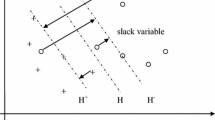Abstract
Parameter learning or design is a key issue in cellular neural network (CNN) theory. If the CNN is implemented as an analog VLSI chip, additional constraints are posed due to its restricted accuracy. Only robust parameters will still guarantee the correct network behavior. We present an analytical design approach for the class of bipolar CNNs which yields optimally robust template parameters. We give a rigorous definition of absolute and relative robustness and show that all well-defined CNN tasks are characterized by a finite set of linear and homogeneous inequalities. This system of inequalities can be analytically solved for the most robust template by simple matrix algebra. Focusing on a particular implementation of the CNN universal chip, we demonstrate that the proposed method can cope with the manufacturing inaccuracies.
Similar content being viewed by others
References
Leon O. Chua and Lin Yang, “Cellular neural networks: Theory,” IEEE Transactions on Circuits and Systems-I, Vol. 35, No. 10, pp. 1257–1272, Oct. 1988.
Leon O. Chua and Lin Yang, “Cellular neural networks: Applications,” IEEE Transactions on Circuits and Systems-I, Vol. 35, No. 10, pp. 1273–1290, Oct. 1988.
Leon O. Chua and Patrick Thiran, “An analytic method for designing simple cellular neural networks,” IEEE Transactions on Circuits and Systems-I, Vol. 38, No. 11, pp. 1332–1341, Nov. 1991.
I. Fajfar and F. Bratkovi?, “Design of monotonic binary-valued cellular neural networks,” IEEE International Workshop on Cellular Neural Networks and their Applications, Sevilla, pp. 321–326, June 1996.
Bahram Mirzai, Drahoslav Lím, and George S. Moschytz, “On the robust design of uncoupled CNNs,” European Symposium on Artificial Neural Networks, Bruges, Belgium, pp. 297–302, April 1998.
Josef A. Nossek, “Design and learning with Cellular neural networks,” International Journal of Circuit Theory and Applications, Vol. 24, No. 1, pp. 15–24, 1996.
C. Güzeli¸s and S. Karamahmut, “Recurrent perceptron learning algorithm for completely stable cellular neural networks,” IEEE International Workshop on Cellular Neural Networks and their Applications, Rome, pp. 177–182, Dec. 1994.
Bahram Mirzai, Zhenlan Cheng, and George S. Moschytz, “Learning algorithms for cellular neural networks,” IEEE International Symposium On Circuits And Systems, Monterey, California, Vol. 3, pp. 159–162, June 1998.
Tibor Kozek, Tamás Roska, and Leon O. Chua, “Genetic algorithm for CNN template learning,” IEEE Transactions on Circuits and Systems-I, Vol. 40, No. 6, pp. 392–402, June 1993.
B. Chandler, C. Rekeczky, Y. Nishio, and A. Ushida, “Using adaptive simulated annealing inCNNtemplate learning-a powerful alternative to genetic algorithms,” European Conference on Circuit Theory and Design, Budapest, pp. 655–660, Sept. 1997.
Tamás Roska and Leon O. Chua, “The CNN universal machine: An analogic array computer,” IEEE Transactions on Circuits and Systems-II, Vol. 40, No. 3, pp. 163–173, March 1993.
S. Espejo, R. Carmona, R. Domínguez-Castro, and A. Rodríguez-Vázquez, “A CNN universal chip in CMOS technology,” International Journal of Circuit Theory and Applications, Vol. 24, pp. 93–109, March 1996.
Drahoslav Lím and George S. Moschytz, “A modular gm-C programmable CNN implementation,” IEEE International Symposium On Circuits And Systems, Monterey, Vol. 3, pp. 139–142, June 1998.
Bahram Mirzai and George S. Moschytz, “Upper bounds for robustness of CNN templates and a design approach for robust templates,” IEEE International Symposium On Circuits And Systems, Atlanta, Vol. 3, pp. 284–287, May 1996.
Bahram Mirzai, Drahoslav Lím, and George S. Moschytz, “Robust CNN templates: Theory and simulations,” IEEE International Workshop on Cellular Neural Networks and their Applications, Seville, pp. 393–398, June 1996.
Peter Kinget and Michiel Steyaert,Analog VLSI Integration of MassiveParallel Signal Processing Systems, Kluwer, Dordrecht, The Netherlands, ISBN 0-7923-9823-8, 1997.
Martin Hänggi and George S. Moschytz, “Genetic optimization of cellular neural networks,” IEEE International Conference on Evolutionary Computation, Anchorage, pp. 381–386, 1998.
Kenneth R. Laker and Willy M. C. Sansen, Design of Analog Integrated Circuits and Systems, McGraw-Hil, ISBN 0-07-036060-X, 1994.
Tamás Roska, L. Kék, L. Nemes, Á. Zarándy, M. Brendel, and P. Szolgay, “CNN software library, vers. 7.2,” Tech. Rep. DNS-CADET-15, Dual & Neural Computing Systems Laboratory, Computer and Automation Research Institute, Hungarian Academy of Sciences, 1998.
Martin Hänggi and George S. Moschytz, “Making CNN templates optimally robust,” International Symposium on Nonlinear Theory and its Applications, Crans-Montana, Switzerland, Vol. 3, pp. 935–938, Sept. 1998.
Ari Paasio, Adam Dawidziuk, Kari Halonen, and Veikko Porra, “About the robustness of CNN linear templates with bipolar images,” IEEE International Symposium On Circuits And Systems, Atlanta, Vol. 3, pp. 555–557, May 1996.
Martin Hänggi and George S. Moschytz, “An exact and direct analytical method for the design of optimally robust CNN templates,” IEEE Transactions on Circuits and Systems-I, Vol. 46, No. 2, pp. 304–311, Feb. 1999.
Martin Hänggi and George S. Moschytz, “Visualization of CNN dynamics,” Electronics Letters, Vol. 33, No. 20, pp. 1714–1716, Sept. 1997.
Martin Hänggi, Simon Moser, Eric Pfaffhauser, and George S. Moschytz, “Simulation and visualization of CNN dynamics,” International Journal of Bifurcation and Chaos, Vol. 9, No. 7, July 1999.
Martin Hänggi and George S. Moschytz, “Stochastic and hybrid approaches toward robust templates,” IEEE International Workshop on Celular Neural Networks and their Applications, V. Tavsanoglu (Ed.), London, pp. 366–371, April 1998.
Drahoslav Lím and George S. Moschytz, “A programmable gm-C CNN implementation,” IEEE International Workshop on Cellular Neural Networks and their Applications, V. Tavsanoglu, London, pp. 294–299, April 1998.
Martin Hänggi and George S. Moschytz, “An analysis of CNN settling time,” IEEE Transactions on Circuits and Systems-I, 1999, accepted for publication.
Rights and permissions
About this article
Cite this article
Moschytz, G.S. Analytic and VLSI Specific Design of Robust CNN Templates. The Journal of VLSI Signal Processing-Systems for Signal, Image, and Video Technology 23, 415–427 (1999). https://doi.org/10.1023/A:1008157421349
Published:
Issue Date:
DOI: https://doi.org/10.1023/A:1008157421349




